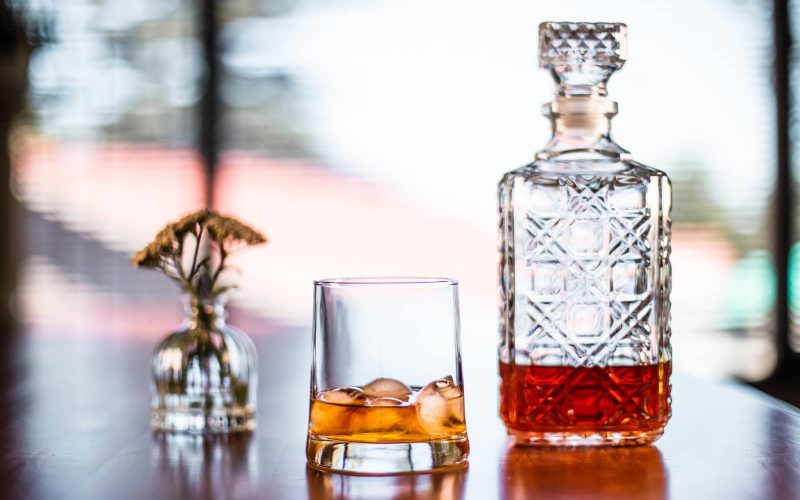Whiskey is a popular alcoholic drink that is elegant and straightforward. Different types of whiskey are available at a wide range of prices.
Some are quite reasonable, and others are highly expensive. Rye, barley, wheat, corn, and sorghum are the grains used to produce whiskey.
To create the alcohol content in this drink, the ingredients are fermented into sugars and then distilled to remove any remaining liquid before being turned into the finished product.
Different Types of Whiskey According to Style
Whiskeys come in a wide range of quality and flavor; if you go in blind, you might not get anything close to what you were hoping for.
So, to help you find the right after-dinner drink, we’ve put together this article on the different types of whiskey, what distinguishes them, and what you can expect from each.
1. Rye Whiskey
Special regulatory requirements for rye whiskey must be observed.
Rye whiskey’s main ingredient is rye grain, which accounts for 51% of the mash. The remaining 49% is corn, wheat, or malted barley.
The alcohol by volume (ABV) of rye whiskey should not exceed 80%. Before being bottled for use, the ultimate output of all that delicious booze is diluted to no more than 62.5 percent ABV or 125 proof. After that, the liquor is put in charred new oak barrels to mature.
Rye whisky’s unique spicy bite and peppery flavor make it ideal for individuals who enjoy a touch of hot spice in their drink.
Rye has a wide range of flavors. Some may have strong flavors and extended finishes that warm you. Others have a stronger bite at first but thin down as they travel down your throat, leaving you feeling like nothing was there!
Depending on your preferred flavor profile, there are many rye beverages.
2. Single Cask Whiskey
This is another type of whiskey that derives its name from being distilled in a single barrel.
Various chemical mechanisms influence maturation pace, flavor profiles, and evaporative loss during whiskey aging.
Temperature control is one of the most important parts of single-cask whiskey production.
Because evaporation impacts flavor, keeping track of how far a barrel’s contents are drawn in and how much of them are exposed to the wood surface area is critical.
Even though distillers use the identical mash bill, yeast, and maturation period, two barrels might produce dramatically different results.
3. Single Malt Whiskey
Single malt whisky is a Scotch whisky made by a single distillery in Scotland.
People frequently believe they are from a single batch and do not enable blending, but this is far from the case!
The term “single” relates to being produced in a single location rather than being sourced from many sources, not to whether or not different batches were mixed during manufacture.
Single malt scotch is also regarded as superior to blended whiskey. More than their contemporaries, they symbolize the distillery and location where they were manufactured.
Because of the peat used to smoke barley and the wood used to make the barrels, the flavors of a single malt whiskey are unique to the location in which it is produced.
This distinct flavor profile pairs well with other artisanal aspects, creating mystique and making each bottle feel like a one-of-a-kind work of art.
4. Blended Whiskey
Blended whiskey, as the name implies, is a mix of different types of whiskey, such as malt and grain.
From distillery to distillery, there are different varieties of whiskey with different styles and origins.
When manufacturing a blended whiskey, at least 20% of the mix must be straight whiskey, with the remaining 80 percent comprising various whiskeys.
Because each distiller provides a unique flavor profile, the blended whiskey’s character is established by combining diverse flavors created by numerous distillers.
The most well-known brands also utilize constant blends during manufacturing, so the flavors rarely shift.
Some individuals avoid blended whiskeys because they feel single malts are superior, but this is false.
Because blended whiskey combines whiskies, it has a wide spectrum of flavors. It has the same complexity and flavor as a single malt but at a lower price.
5. Straight Whiskey
Although there are different types of whiskey, they all fall under the same tent.
Bourbon, rye, wheat, and malt whiskeys are classified as “straight” if they are new or have been aged for at least two years.
Straight bourbon whiskey is produced in strict accordance with some requirements.
It must meet three criteria to be classified straight: it must not exceed 80 percent ABV, contain at least 51 percent maize, and have been barreled in new charred oak barrels for at least two years at no more than 62.5 percent ABV.
“straight bourbon whiskey” and “straight rye whiskey” are frequently used.
If you merely see the words “straight whiskey,” it signifies the product doesn’t fulfill the legal requirement of at least 51 percent single grain.
As a result, it doesn’t qualify as anything else, such as bourbon. Furthermore, without being dubbed a “blend,” a straight whiskey can combine two or more straight whiskeys from the same state.
6. Malt Whiskey
Like single malt, malt whiskey is made from a fermented mash of malted barley.
Other malted grains can be used, but whiskeys must be labeled with their grains, such as “rye malt whiskey” or “buckwheat malt whiskey.”
A “single malt whiskey” is produced by a single distillery.
7. Light Whiskey
Although light whiskey is frequently confused with diet or low-calorie beverages, it has nothing to do with calories.
Light whiskey used to be the standard. It was first released in 1968, and only a few small distilleries have produced bottles that are still available today.
It’s lighter than regular whiskey but darker than grain spirits, falling in the middle in hue.
A whiskey’s ABV must be between 80 and 95 percent light. This alcohol’s maturation requirements aren’t as stringent as those of other whiskeys.
Light whiskeys are becoming a common ingredient in blended whiskeys, particularly Canadian whisky.
Different Types of Whiskey According to Location
1. Scotch Whiskey
The world of Scotch whisky is full of taste and tradition. Most people believe that Scotch whisky must only contain malted barley; however, any grain can be used as long as malted barley is present. On the other hand, single-malt Scotch whisky must be pot distilled.
More flavored congeners will stay in the spirit due to pot distillation.
It has a lesser yield than column distillation, which allows you to manufacture higher volumes of high-quality spirits with less labor and energy.
Regarding alcohol concentration, Scotch whisky must have a maximum ABV of 94.8 percent, while bourbon only has an ABV of 80 percent.
Furthermore, both have the potential to be bottled at higher levels than their respective maximums.
One distinction is the maturing requirements: Scotch whisky must be aged for three years or longer, but bourbon does not.
Fruit cake, flowers, dried fruits, toffee, heather honey, malt, seaweed salt, and walnuts are just a few of the tastes and flavors found in Scotch.
2. Japanese Whiskey
Japanese whisky follows the Scotch tradition of double distilling malted or peated barley, followed by aging in wood barrels.
They’re drier, smokier, and peatier than American bourbons or ryes, typically sweeter. They’re available as single malt or blended versions.
Because this whisky shares many characteristics with Scotch, the “e” is omitted. Japanese whisky is becoming increasingly popular in the Western world.
The first Yamazaki distillery was established in Kyoto in the 1920s, and Japanese whiskies were primarily sold within Japan for most of the twentieth century.
Due to its growing popularity, Japanese whisky is now being exported to Europe and North America for global sale.
3. Irish Whiskey
Although single-malt Irish whiskey exists, Irish whiskey is created from unmalted barley combined with grain whiskeys.
Like the other types of whiskey, Irish whiskey is produced exclusively in its home country.
The triple distillation process brings out Irish whiskey’s distinct flavor profile. With their favorite whiskey gaining popularity worldwide, the Irish are making waves in spirits.
With more brands than ever before and unrivaled smoothness, now is the ideal moment to pour yourself or make up an Irish cocktail!
However, to be named Irish whiskey, it must have two elements. The first requirement is distilling the spirit from a malt and cereal grain mash in Ireland.
Furthermore, only pots and spirits can be used on cereals grown in Ireland. Irish whiskey is required by law to be aged in barrels for a minimum of three years.
Irish whiskey is produced from unmalted barley, though certain types may contain malted barley.
Drying the malt in closed kilns ensures it does not come into contact with smoke.
Additional enzymes can prepare the fermented starch for conversion to alcohol. Before maturing, it must be distilled three times in copper pot stills.
Although some employ continuous column stills, grain whiskey is only distilled in pots.
4. Canadian Whiskey
Canadian whiskey is a spirit manufactured from mashed and distilled cereal grains aged for at least three years in Canada.
The final step in making Canadian whisky is ensuring it has at least 40% alcohol by volume.
This allows Canadian whisky blenders much more freedom when experimenting with new concepts, as fewer constraints exist.
You’re ready for your first tasting if the drink follows these principles and preserves its established character, flavors, and scents.
It’s fascinating to learn about the history of whiskey in Canada. Canadians were famed for wheat whiskey production before rye was introduced to the wheat mash.
5. American Whiskey
Bourbon isn’t the only type of American whiskey. Rye, Tennessee, and corn whiskeys are also available.
Thanks to the advent of microdistilleries, whiskeys are now created all over the country, from New York to California.
American whiskeys are sweeter, have less smokiness, and are usually less expensive.
Although each sort of American whiskey has its features, they all begin similarly.
They’re created using a blend of corn, rye wheat, and barley matured in charred oak barrels to give them their particular flavor.
Below are two types of American whiskey to try out.
i. Tennessee Whiskey
Regarding Tennessee whiskey, the state has its own set of regulations.
It’s usually prepared from corn and filtered over charcoal, giving it a distinct mellow flavor.
Typically, Tennessee whiskeys go through a process known as the Lincoln County Process.
Furthermore, a true Tennessee Whiskey must be brewed with at least 51% maize in the mash bill. Other grains such as barley, rye, or wheat can provide the remaining 49%.
When distilled, the spirit must never exceed 80% alcohol by volume, and it cannot exceed 125 proof in oak barrels before being bottled.
It must be bottled at a minimum of 80 proof. Some even reach a proof of 125-140.
The final phase in the long process of making Tennessee whiskey is barrel aging.
It, like bourbon, must be aged in new charred oak barrels, but there is no precise minimum age requirement for this whiskey type.
ii. Bourbon Whiskey—Kentucky
Bourbon whiskey is a type of whiskey made with at least 51% corn in the mash bill.
Distillers typically use about 70% corn in their mash bill and then choose which grains to include to round out the bill.
Depending on the type of grains used, different flavors of bourbon emerge.
Bourbon is a quintessentially American spirit, but many people are astonished to hear that it may be produced anywhere in the United States.
It isn’t unique to Kentucky, though it does supply 95 percent of the world’s supply. Every year, new bourbon distilleries spring up all across the country.
The beginning of the bourbon-making process is similar to the beginning of the sourdough bread-making procedure.
It entails taking the leftovers from a previous batch and fermenting them overnight before adding them to a freshly fermented mash.
Bourbon should be matured for at least two years before bottling. Some, on the other hand, take as long as 27 years.
Frequently Asked Questions
There are several ways to enjoy whiskey, but one simple way is to drink it neat, with a splash of ice water between sips. Some individuals use a few drops of water to open the flavors as the liquids mingle. If you have patience, you can try experimenting with whiskey and water. When sipping whiskey directly from the whiskey glass, it’s all about figuring out what works best for you.
Whiskey has a lot more alcohol in it than a typical beer. ABV, which stands for alcohol by volume, is the standard measurement for a whiskey’s alcohol level. While most beers don’t exceed 10% ABV, whiskey typically starts at 40%. Some countries even prohibit using “whiskey” if the alcohol content is less than 40%.
Flavored whiskeys have flavorings added to them to enhance their original flavor. Apple, cinnamon, and honey are all common flavorings. They’re mostly created in North America, but a few European variations exist.
Conclusion
There are different types of whiskey than you might expect. Different production procedures and the area where they’re created can explain the disparities in flavor profiles and textures.
They also differ depending on the grain used in distillation and when the final product is aged. You can better understand and appreciate them if you learn more about them.
What are your favorites among the different types of whiskey? Let us know what you think in the comments!








